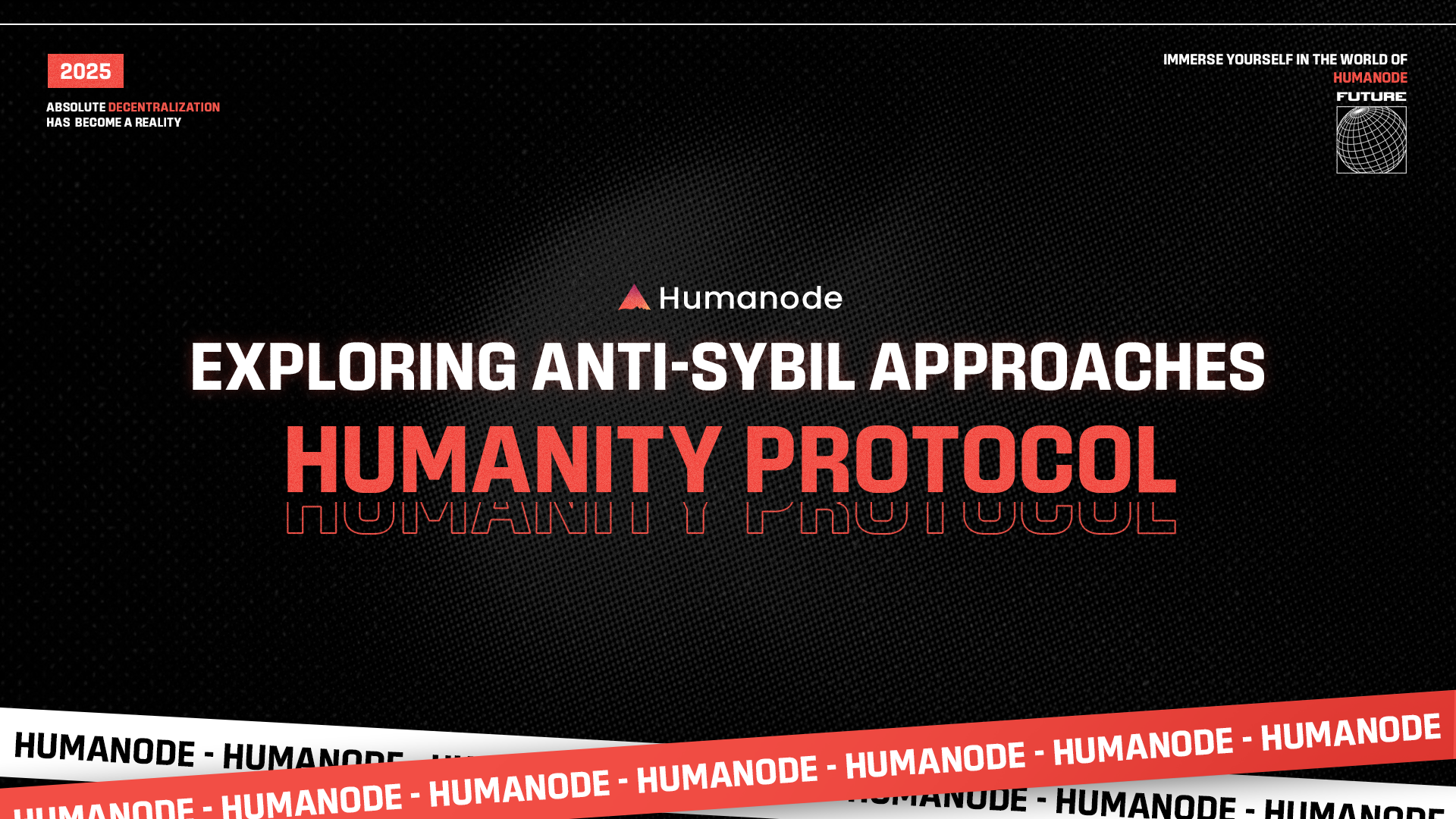Exploring Anti-Sybil Approaches: Humanity Protocol

AI generated content is everywhere. It fills timelines, writes comments, and even runs accounts that look convincingly human. As AI agents start posting, trading, and joining communities, the internet’s biggest question is shifting from “What’s real?” to “Who’s real?”
Recent reports back this up. A16z’s October 2025 AI Application Spending Report found that most of the top 50 AI native startups are building tools that replace or imitate human behavior, not just automate infrastructure. That means the web is steadily filling up with AI agents that look, talk, and act like us.
Another study found that researchers tracking long form content estimate that nearly 40 percent of articles and comments posted online this year were AI generated.
This shift isn’t just about fake engagement or spam. It’s changing the nature of online trust. In a web full of machine voices, knowing who’s human is turning into the foundation for everything from governance and incentives to reputation and democracy. That’s what kicked off this series: Anti-Sybil Approaches
At Humanode, we’ve been working on this for a while. Building Biomapper, BotBasher, and OAuth2.0 that prove you’re human without handing your face or ID to anyone, and all that based on a chain with a whole new consensus mechanism, Proof of Biometric Uniqueness (PoBU), which brings human beings, not capital, to the center of the equation. But this challenge is bigger than one network or one approach. Around the world, builders are experimenting with new ways to establish human uniqueness through social graphs, zero knowledge proofs, biometrics, or compliance systems, and each brings its own lessons.
In the last two pieces, we talked about Proof of Humanity and Civic.
Now we turn to Humanity Protocol, one of the newest players in the proof of personhood space. It is backed by Animoca Brands and built on zkSync, using palm recognition for biometric verification and decentralized identifiers to create portable, privacy-friendly identities.
Humanity Protocol claims to merge the best of both worlds: Web3 decentralization with real world identity validation. In this piece, we will look at how it works, what it promises, and what it tells us about the next stage of human verification in the age of AI.
What is Humanity Protocol?
Humanity Protocol showed up recently in the proof of personhood space. It started in 2023, backed by Animoca Brands, and runs on zkSync, a Layer 2 built on Ethereum.
The pitch is simple: prove you’re a real human once, without giving up your data. It uses palm recognition for verification and decentralized identifiers (DIDs) to represent each verified person on-chain.
Here’s roughly how it works. You scan your palm. The system turns that scan into a kind of fingerprint made of numbers, a hashed version called a Palm ID, and ties it to your DID. That DID becomes your proof of personhood. You can reuse it across apps without showing your palm again or uploading any documents.
Humanity Protocol sits somewhere between old-school KYC and privacy-first biometrics. It doesn’t collect passports or store images, but it still roots identity in something physical, your hand. They call it a "proof of humanity layer" for Web3 and AI systems. The idea is that DAOs, games, or dApps can plug it in and know there’s a human behind every wallet.
It’s still early days, but the concept points toward a bigger shift: mixing on-chain infrastructure with real world verification to keep the web human as AI activity keeps growing.
How Humanity Protocol Works
Let’s get into how Humanity Protocol actually works.
You start with their mobile app. It asks for a palm scan, not a photo, but a capture of your palm’s unique pattern. The image doesn’t go on-chain or to some central server. It’s turned into a hashed code that represents your palm, something that can’t be reversed back into the real thing.
That hash is then tied to what’s called a decentralized identifier, or DID. Think of it like a digital passport that says, “this wallet belongs to a verified human,” without revealing who that human is. Once you’ve got it, you can reuse it across apps and dApps that support Humanity Protocol without scanning again or uploading documents.
The team says they use zero knowledge proofs to let you prove you’re verified without sharing your data. It’s a privacy-first setup, at least on paper. Each new scan is also compared against all existing ones to make sure no one can register twice, what they call a uniqueness check.
In early testing, Humanity Protocol claimed to have processed millions of human IDs and hundreds of millions of related transactions, though independent audits aren’t public yet.
Once verified, your DID acts as your reusable proof of personhood. It works across different platforms, from AI agents to DeFi apps, all without giving away your real-world identity.
The data, according to the team, stays encrypted or on the device, and users can delete their template if they choose to leave. The rollout is happening in phases: first ID reservations, then mobile palm scans, and later, infrared palm vein scanners for stronger security.
One important note is that future phases described by the team include specialized hardware devices for palm-vein imaging. This would move verification away from a simple mobile camera experience toward dedicated scanners for higher accuracy and spoof resistance. If adopted, this introduces a reliance on external hardware, which changes who can participate and how accessible the system remains over time.
It’s a system still in motion, but the goal is clear: one human, one identity, without turning verification into surveillance.
Decentralization and Governance in Humanity Protocol
Humanity Protocol operates on zkSync, a Layer 2 built on Ethereum. This gives it access to Ethereum’s security layer while using rollups for lower fees and faster transactions.
The protocol’s on-chain components, such as identity credentials and verification proofs, rely on zkSync’s infrastructure. However, the off-chain part, palm scanning, template generation, and ID issuance, is currently managed by the Humanity Protocol team and its technical partners. Public details about validator roles, governance structure, or community participation are limited.
There is no information yet on whether the protocol plans to introduce an open validator model, decentralized governance, or token-based decision-making. Most of the control, as of now, remains with the core development team and its associated entities.
In its current form, Humanity Protocol functions as a permissioned identity system that leverages decentralized infrastructure. Governance details are still evolving, and technical documentation outlining future decentralization plans has not been released publicly.
User Experience and Adoption
Humanity Protocol is still in its early stages, but the team has shared glimpses of how the user experience works. Enrollment happens through a mobile app that asks users to scan their palm using the device camera. This mobile flow is the current experience. Later versions may require users to verify through certified palm-vein hardware scanners operated by partner locations.
The scan is processed locally, turning it into a hashed template called a Palm ID. The original image is not stored, and the user receives a decentralized identifier (DID) that represents them on-chain.
Once verified, users can connect this DID across apps and platforms that integrate Humanity Protocol. The idea is that one scan creates a reusable identity that doesn’t need to be repeated for every new service. This portability makes it easier for developers to add proof-of-personhood checks without designing their own identity systems.
The protocol’s website and early test announcements mention plans for a tiered verification model. The first version uses simple palm surface patterns, while later iterations may include palm-vein recognition for higher accuracy. The project also plans to support verifiable credentials that users can share privately when interacting with dApps or Web3 platforms.
As of now, Humanity Protocol has not opened full public enrollment. A waitlist and beta access were introduced earlier in 2025, with reports of thousands of sign-ups and partnerships forming across the zkSync ecosystem. Broader adoption metrics, such as the number of verified users or active integrations, have not yet been made public.
Strengths and Limitations
Humanity Protocol introduces a few ideas that stand out in the proof-of-personhood space.
It uses palm recognition instead of facial biometrics, which can reduce some privacy and accessibility concerns. Palm patterns are harder to spoof and carry less cultural or demographic bias than facial data.
Its use of zkSync for on-chain infrastructure also means lower transaction fees and faster verification compared to many Ethereum-based identity systems. The combination of decentralized identifiers (DIDs) and verifiable credentials suggests an effort to create reusable digital identities that stay under user control rather than being stored in centralized databases.
The project has also gained attention for its backing from Animoca Brands and its stated focus on combining Web3 identity with AI-age challenges.
Despite its potential, Humanity Protocol is still early. Public information about the system’s architecture, privacy model, and governance structure remains limited.
The verification flow relies on company-operated systems, and the protocol’s decentralization roadmap has not been released in detail.
There is also the question of hardware dependence. If dedicated palm-vein scanners become required, verification access may shift toward physical locations or approved devices, creating friction and raising cost barriers similar to other hardware-based proof-of-personhood systems.
It’s also unclear how uniqueness is guaranteed at scale or how one-to-many palm checks are handled without exposing sensitive data. Since the project has not yet completed a full public rollout, its ability to maintain both privacy and accuracy in large-scale environments has not been tested. Also, the accuracy of palm recognition using a mobile camera is subject to questioning.
Summing Up
Humanity Protocol represents a new wave of identity systems designed for the age of AI, where the line between human and synthetic participation is blurring. It sits somewhere between compliance-grade identity and privacy-first verification using biometric proofs while keeping them off-chain.
Like other approaches we’ve explored, it’s part of a broader search for balance between trust, privacy, and decentralization. What Humanity Protocol adds to the conversation is the use of new biometric modalities and its attempt to make those identities reusable across Web3.
Every project we’ve looked at in this series, Proof of Humanity, Civic, and now Humanity Protocol, takes a different route to the same question: how do you know there’s a real person behind a wallet or an action on-chain?
At Humanode, our approach starts with cryptobiometrics and privacy-first verification, built on the consensus of real humans rather than capital. Our vision goes beyond a digital identity solution and aims to be a framework of fairness, decentralized governance, and a building block for a decentralized global economy while providing security and privacy.
But this series isn’t about declaring a winner. It’s about mapping the field and understanding what each approach gets right and where it still struggles.
Humanity Protocol adds to that map. It brings new biometric ideas and a link to zk ecosystems, showing how identity might evolve in a world where AI and humans coexist online.
Next, we’ll explore another project tackling this from yet another angle. Different tools, same mission: keeping the internet human.

